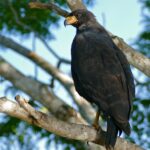Great black hawks, scientifically known as Buteogallus urubitinga, are tropical New World birds that primarily reside in coastal areas with forests and open woodlands near water. They are resident breeders, meaning they do not migrate and stay in their habitats all year round. Adult great black hawks are 56 to 64 centimeters long and weigh 1.1 kilograms, with broad wings and a short tail that is white with a broad black tip. Their diet mainly consists of reptiles, small vertebrates, and large insects, which they often hunt on foot.
The Ratchet-like Mechanism for Secure Sleeping
As great black hawks begin to nod off, a ratchet-like band of tissue tightens around the inside of their leg, locking their grip on the branch. This mechanism ensures that they don’t fall off during sleep, which is particularly useful during unfavorable weather conditions, such as rainy or windy nights, when finding a secure perch is crucial.
Unihemispheric Sleeping Behavior
 Image source: Great Black Hawk by Bernard DUPONT
Image source: Great Black Hawk by Bernard DUPONT
While there is limited information specifically about how great black hawks sleep, studies on other bird species, such as Swainson’s hawks, have revealed interesting sleeping patterns. Swainson’s hawks have been observed to sleep unihemispherically, meaning one half of their brain remains alert while the other half sleeps. This behavior allows them to maintain some level of awareness while resting, which can be beneficial for survival. It is unclear whether great black hawks exhibit similar sleeping patterns.
Factors Affecting Great Black Hawks’ Sleep
Weather Conditions
As mentioned earlier, the ratchet-like mechanism that secures great black hawks’ grip on branches is particularly useful during unfavorable weather conditions, such as rainy or windy nights. These conditions can make it challenging for the birds to find a secure perch, and the locking mechanism helps them stay safe during their sleep.
Predator Presence
The presence of predators in the area can also affect the sleep patterns of great black hawks. Like other birds, they may need to remain more alert and vigilant, potentially reducing the depth or duration of their sleep, to ensure their safety.
Breeding Season
During the breeding season, great black hawks may exhibit different sleeping behaviors compared to the non-breeding season. For example, they may need to spend more time awake to guard their nests, feed their young, or engage in other breeding-related activities.
Sleeping Posture and Roost Selection
Great black hawks typically roost on high branches or in the upper canopy of trees, where they can have a clear view of their surroundings. They may also choose to sleep in areas with dense foliage or near water sources, which can provide additional protection and resources.
When sleeping, great black hawks often adopt a characteristic posture, with their head tucked under their wing and their feet gripping the branch. This posture helps them conserve body heat and maintain a secure grip on their perch.
Conclusion
In conclusion, the great black hawk’s unique sleeping mechanism, involving a ratchet-like band of tissue that secures their grip on branches, is a fascinating adaptation that helps them sleep safely in their environment. While specific details about their sleeping patterns are limited, it is clear that these birds have evolved strategies to ensure their rest and survival, such as unihemispheric sleeping and the selection of secure roosts. Further research is needed to fully understand the intricacies of how great black hawks sleep and the factors that influence their sleeping behavior.
References:
– Why do hawks avoid to fly at night?
– Swainson’s Hawks Sleeping Unihemispherically
– Where Do Hawks Sleep?
– Great Black Hawk (Buteogallus urubitinga)
– Common Black Hawks
– Great Black Hawk


